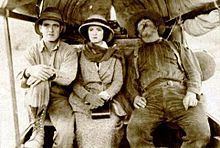Cinematography Harry Thorpe | Initial release 6 March 1922 Producer Carl Laemmle Distributed by Universal Pictures | |
 | ||
Based on Wild Honey: Stories of South Africaby Cynthia Stockley Release date February 27, 1922 (1922-02-27) (New York) Cast Wallace Beery, Priscilla Dean, Noah Beery Sr Similar Love, Outcast, Honey, Street Girl, Accent on Youth | ||
Wild honey it s all in the film
Wild Honey is a 1922 American silent romantic adventure film produced and distributed by the Universal Film Manufacturing Company and directed by Wesley Ruggles. Based on a book of the same title by Cynthia Stockley and starring Priscilla Dean, the film also features Noah Beery, Sr. and Wallace Beery in supporting roles. It is notable for the first use of a traveling matte special effect.
Contents
It is not known whether the film currently survives.
Synopsis
Despite her father's debt to him, Lady Vivienne (Priscilla Dean) refuses to marry the wealthy but villainous Henry Porthen (Noah Beery). Porthen devises a plot to lure Vivienne to his country home using her weak-willed friend, Freddy (Lloyd Whitlock). In the course of events, Vivienne faints, Porthen is killed by his secretary Joan (Helen Raymond), and Freddy runs away for fear that he will be blamed.
Three years later, Vivienne travels to Transvaal to investigate some problem property she owns. She is rescued from bandits by homesteader Kerry Burgess (Robert Ellis) and the two fall in love. More intrigue brought about by Vivienne's rejection of another suitor, Wolf Montague (Landers Stevens), leads to the sabotage of a dam and a destructive flood. Vivienne tries to warn the settlers in the flood's path and is herself swept up in it. Burgess rescues her again and they are united.
Production
Cynthia Stockley's novel Wild Honey was purchased by Universal in 1921 with Priscilla Dean already in mind. Brothers Wallace and Noah Beery appeared for the first time in the same feature film.
This was the first film in which a traveling matte process (called the "Williams process" after its inventor) was used. The action of the players was filmed against a black screen, and a scene in miniature of a bursting dam and consequent flood was filmed separately, then the two were combined by the process.
Release
Wild Honey opened in New York at the Central Theatre on February 27, 1922.
Reviews were mostly negative, but many critics singled out the flood scene as impressive and some regarded it as worth the price of admission. The Variety review expressed the opinion that the movie was cheaply made and that, except for the flood scene, the production suffered as a result. Reviewing the film for Life, Robert E. Sherwood called it "a pitifully weak piece of work". The capsule review in Photoplay labeled it "as dull an evening's entertainment as you can find anywhere".
